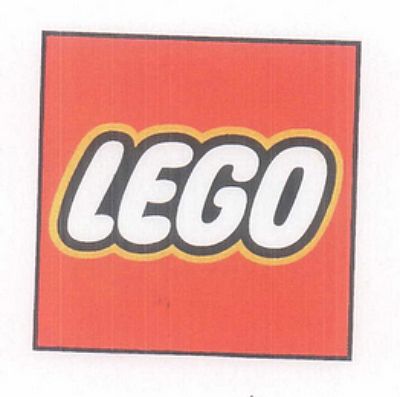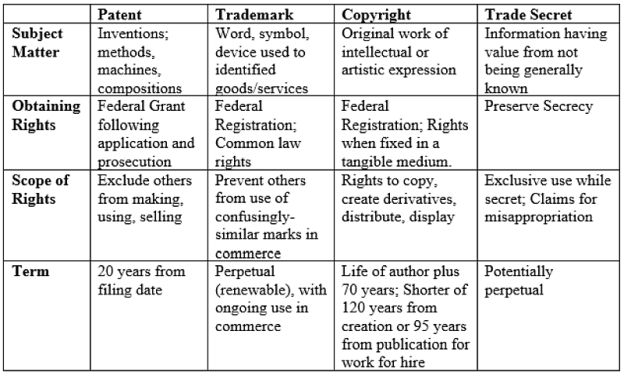Differentiating Protection Mechanisms for IP Ranging from Aspirin to Coca-Cola® and from The Empire Strikes Back to KFC's Original Recipe.
The United States Intellectual Property Alliance (USIPA) recently published the results of its US Intellectual Property Awareness & Attitudes Survey. Among its findings, the survey results revealed that 70% of Americans are unable to distinguish between mechanisms – patents, trademarks, copyrights, and trade secrets – for protecting Intellectual Property (IP).
Given these results, it's worth exploring the principal mechanisms for protecting IP, which each possess some distinctive features.
Patent – an intellectual property right for an invention.
- Subject Matter: "useful" inventions that are "novel"1 and "non-obvious," including processes (methods), machines, manufactured goods, and compositions of matter (chemical, biological, other).
- Examples of Patented Inventions:
U.S. Patent No. 644,077 for Acetyl salicylic acid (Aspirin), granted in 1900 (expired in 1917).
U.S. Patent No. 3,005,282 for Toy building brick, granted in 1961 to G. Kirk Christiansen, founder the company now known as the LEGO Group (expired 1978). - Obtaining Rights: Complex application and prosecution
process.
In the U.S., the process is regulated by the U.S. Patent and Trademark Office (USPTO) under the authority of the federal Patent Act. There is no "common law" protection. - Scope of Rights: Exclude others2 from making, using, offering to sell or selling, or importing the patented invention within the jurisdiction granting the patent (e.g., United States for patent granted by USPTO).
- Term of Rights: 20 years from the filing date of the patent application.
- Public Policy: "To promote the progress of science and the useful arts, by securing for a limited time ... to inventors the exclusive right to their ...discoveries." Constitution of the United States, Art. I, Sec. 8, Cl. 8. The limited period of protection is provided in exchange for an "enabling" disclosure of the invention, which is dedicated to the public when the patent expires.
Trademark – an intellectual property right for a device that identifies the source of goods or services in the marketplace.
- Subject Matter: A "distinctive" word, phrase, symbol, design, or other device used in commerce to identify the source of goods or services.
- Examples of Trademarks:
U.S. Trademark Registration No. 22406 for Coca-Cola, registered in 1893 (remains issued and active).

U.S. Trademark Registration No. 1026871 for LEGO, registered in 1974 (remains issued and active).

- Obtaining Rights: Application and prosecution process;
Tailored common law rights from actual use of the trademark in
commerce.
In the U.S., the federal registration process is regulated by the USPTO under the authority of the federal Lanham Act. There is some "common law" protection available at the state level. - Scope of Rights: Prevent others using the protected mark or a similar mark in a way that is likely to cause confusion in the marketplace about the source of goods or services.
- Term of Rights: Perpetual (renewable), with ongoing use in commerce.
- Public Policy: To provide consumer protection by preventing the public from being misled as to the origin of goods or services, and to incentivize firms to invest in providing quality goods and services.
Copyright – an intellectual property right for an original work of intellectual and artistic expression.
- Subject Matter – An original work of intellectual and artistic expression, such as a book, photograph, movie, music, software program, painting, drawing, sculpture, or architecture.
- Examples of Copyrights:
U.S. Copyright Registration No. PA0000045692 for a motion picture entitled The Empire Strikes Back to Lucasfilm, Ltd, employer for hire, registered in 1979.
U.S. Copyright Registration No. TX0009229007 for a text entitled Demon Copperhead to Barbara Kingsolver, registered in 2023. - Obtaining Rights: Registration process; Common law
rights when the work is fixed in a tangible medium.
In the U.S., copyrights are regulated by the U.S. Copyright Office (USCO) under the authority of the federal Copyright Act. - Scope of Rights: Copy (reproduce), create adaptations (derivative works), distribute, or publicly display the work.
- Term of Rights: Life of the author plus 70 years; or for works made-for-hire, the earlier of 120 years after creation or 95 years after first publication.
- Public Policy: "To promote the progress of science and the useful arts, by securing for a limited time to authors...the exclusive right to their...writings." Constitution of the United States, Art. I, Sec. 8, Cl. 8. After the limited period of protection, the subject matter of the copyright is dedicated to the public.
Trade Secret – an intellectual property right for information that derives economic value or business advantage from not being generally known.
- Subject Matter – Information that is capable of being maintained in secrecy, such as client lists, marketing plans, pricing and discount structures, production processes (methods), chemical formulas (that cannot be reverse engineered using products introduced into commerce), and software source code.
- Examples of Trade Secrets:
KFC Original Fried Chicken Recipe
WD-40 Formulation
Coca-Cola Syrup Formulation - Obtaining Rights: Make reasonable efforts to preserve
secrecy.
In the U.S., trade secrets are protected at the federal level under the Economic Espionage Act and the Defend Trade Secrets Act. Virtually every state has adopted a version of the Uniform Trade Secrets Act. - Scope of Rights: Exclusive use while secrecy is maintained; Bring claims for misappropriation.
- Term of Rights: Perpetual, while secrecy is maintained.
- Public Policy: Protecting property rights, deterring theft and deterring unfair competition, and aligning with international intellectual property standards.
The following chart summarizes the distinctions between the principal mechanisms for protecting IP highlighted above.

The USIPA and its state affiliates, such as the Kentucky Intellectual Property Alliance (KYIPA), follow a mission including three pillars, one of which is IP awareness and education. Mandy Wilson Decker is the KYIPA Board of Advisors Chair and a Member in the Intellectual Property & Technology Service Group at Stites & Harbison, PLLC.
Footnotes
1. If an invention is described in a printed publication, or is in public use, on sale, or otherwise available to the public before a patent application is filed, these actions by an inventor could eliminate the ability to obtain a patent by destroying the "novelty" requirement.
2. A patent does not grant an inventor the right to practice the invention, rather it is a right to exclude others from practicing the invention. It is possible for an inventor to receive a patent on a novel and nonobvious improvement that makes use of underlying technology owned by another party, such that practicing the improvement might infringe rights of the other party, absent an agreement.
The content of this article is intended to provide a general guide to the subject matter. Specialist advice should be sought about your specific circumstances.
